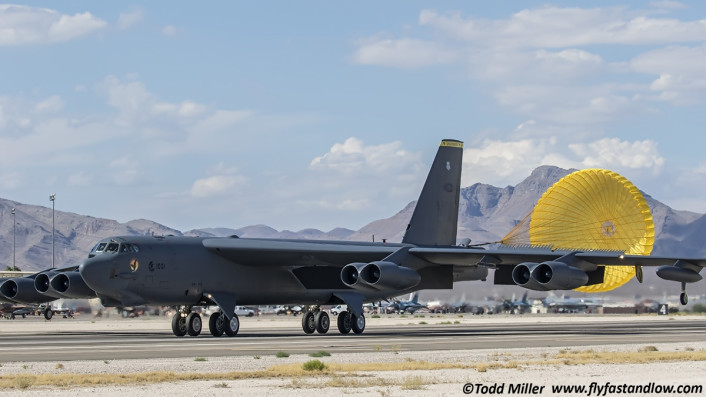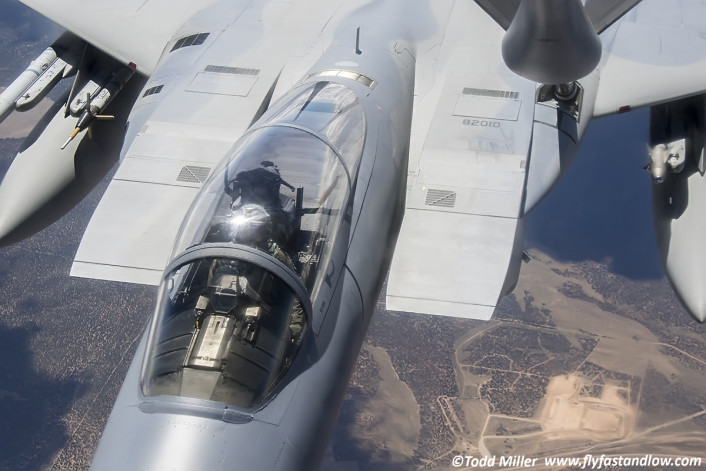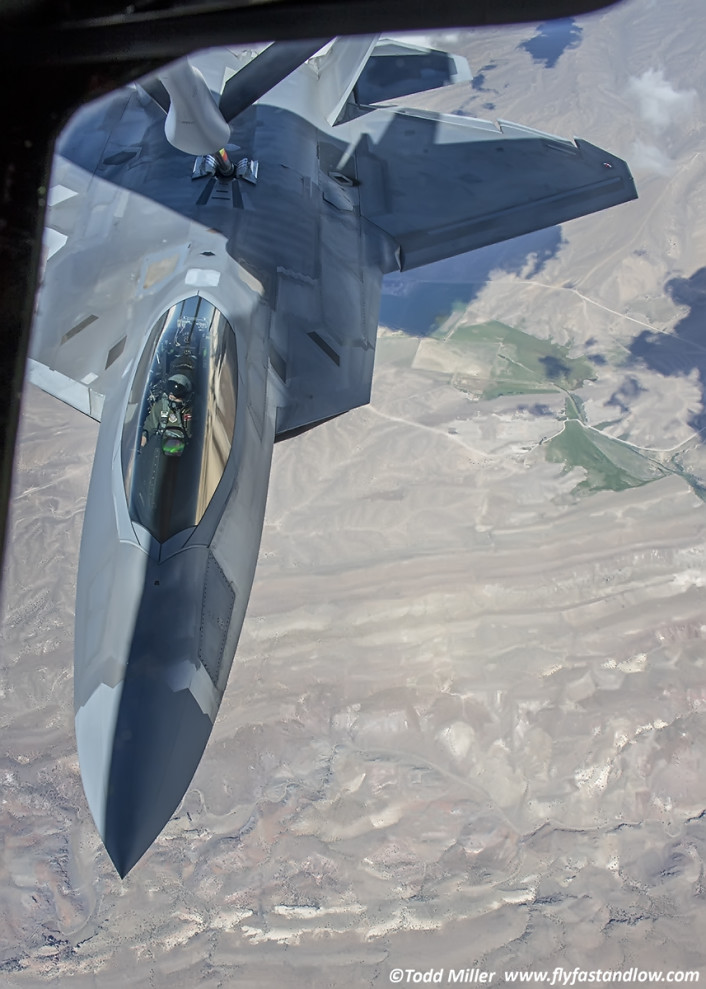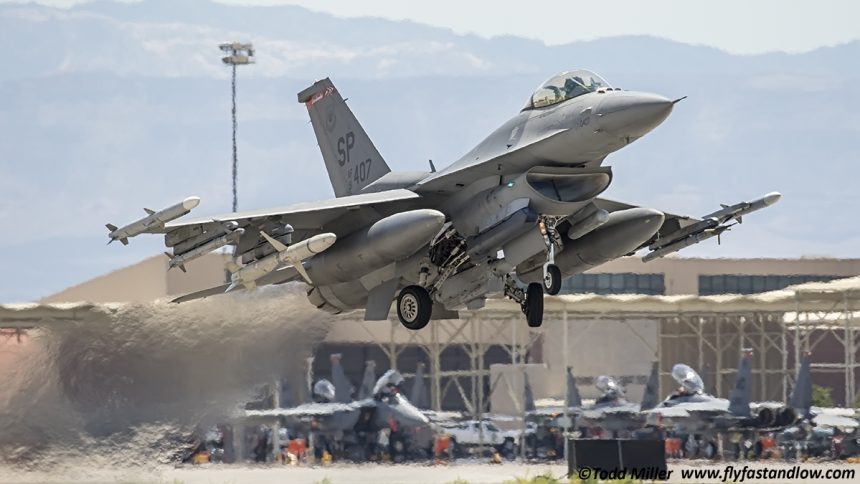We have also taken part in an aerial refueling mission: “nobody kicks ass, without tanker gas!”
Red Flag is well known as the world’s premier aerial warfighting exercise. Featuring the broad expanse of the Nevada Test and Training Range (NTTR), (1000+ potential targets, surface to air missile sites etc.) as well as Air, Space (surveillance, communication) and Cyber assets, the exercise is designed to challenge participants with cutting edge and real world warfighting experience.
The civilian observer notes only those battles that are seen with their eyes or overheard on scanner frequencies. However the warfare is dramatically impacted by what cannot be seen or heard by the outside observer. Beyond the theatres of land, sea, & air – the new theater for battle is “cyberspace.” Closely associated with cyberspace is warfare in the electromagnetic (EM) spectrum. Wireless signals, jamming radars, or GPS all have formidable impact on the success of any modern military campaign. Though capabilities are seldom discussed in any detail, “cyberspace” is as real as any physical theatre. As civilians we utilize cyberspace and the electromagnetic spectrum each day through gps, satellite radio, car remotes, smartphones, wireless routers and corporate networks. Military devices utilize variants of the same technologies, and yet these technologies can be disrupted, and these disruptions must be accounted for and overcome. The ability to fight in and control cyberspace and the related “electromagnetic spectrum” is critical to the success of an effective military campaign against a well prepared adversary.

“…be advised, we are not receiving surveillance.”
“Baron copies, we are working on it.”
Red Flag not only calls on the traditional assets of air and ground, but utilizes space assets, as well as cyber and the electromagnetic in the exercise. Virtual participants participate on some level, networks are attacked, navigation systems interfered with and the attacks are countered. This is likely behind the radio chatter monitored one day between what was clearly command and control personnel and aircraft flying for Red Air “..be advised, we are not receiving surveillance.” “Baron copies, we are working on it.” Radars and weapon systems may be jammed or spoofed, and through it all, participants must react, complete their missions and live to fight another day. In this space, Red Flag is like no other exercise on the planet.

Now in its 40th year, and the latest Red Flag wrapped up Jul. 31, 2015 (the third of four exercises planned for 2015). This session was a 3 week exercise with participation from a wide variety of primarily USAF units, with participation from the Navy & Marines (unit list here). While Red Flag typically involves international participants, Red Flag 15-3 featured such only on an exchange basis.
A successful air campaign in today’s environment requires careful coordination of specialized assets to ensure success. –Red Flag involves “Red Air” (the bad guys) against “Blue Air” (the good guys). Reflecting development of a trend that started some time ago more and more visiting units are rotated through “Red Missions.” This certainly increases the complexity and realism of the exercise, as well as the opportunity to learn – with crews playing and experiencing many more scenarios. Each day brings new challenges that reflect what one might run into in the real world, from confrontation with a global power, to dealing with a rogue nation, a terrorist enclave, precise targets, and/or targets of opportunity.

The value of Red Flag must be seen through the context of maintaining a capable, experienced military force, even while military personnel is constantly changing through attrition and recruiting. The need to train personnel cannot be under estimated, and there is no better place then Red Flag for personnel of all disciplines to complete their first 10 combat missions.

As was made clear by Capt. Britt, aircraft commander of a B-52H bomber in the 69th Bomb Squadron (Minot AFB) units prepare for Red Flag vigorously prior to arrival to ensure they are ready to participate effectively. 1st Lt. Joseph added that their unit considers participation in Red Flag as their “superbowl.” They compete among aircraft and among crews to push each other to greater excellence.

“Ivan one, target the bomber 040, 35, 35,000” (Ivan One).
Participants in Red Flag indicated that the greatest value of the exercise is the integration with the other units in the exercise. As indicated by Capt. Britt, it is one thing to have theoretical knowledge of assets such as the EA-18G Growler, it is altogether another to work with it in the air, and understand the capabilities of what it can do to jam enemy radar and protect the big bomber (fighting in the EM spectrum).
Make no mistake about it, as much as Red Air wants to take out Strikers (such as F-16s or F-15E Strike Eagles on ground attack missions) the big bomber is a desired target as noted by monitoring Red Air radio channels, “Ivan Two, you are going to be targeting the heavy bomber 035 – 35,000” (Ivan). “Flanker 4, your targeting is going to be low striker groups 085 – 20 miles, 7,000” (Flanker 4). “Ivan one, what luck?” (Ivan one clean). “Ivan one, target the bomber 040 35, 35,000” (Ivan One). “Ivan Two, target strikers 030 – 19,000 two ship” (Ivan Two). “Ivan One, what luck on the bomber?” (targeted). “Locked hostile, continue there. Ivan Two snap 030 heavy bomber. Ivan Two” (Fox three, nose 8 mile). “Ivan One, skip it retarget 040 – 35,000 beam west Ivan One” (One).
I suspect the B-52 crew, along with its own electronic warfare (EW) team is thankful to have Growlers and Raptors in the air on and at their side! Having “real” experience to understand the role and capabilities of the assets on your team is critical to build trust in each other, and clear the “fog of war” so the mission can be executed successfully.

A flight in one of Blue Air’s assigned KC-135 tankers exposes yet another dimension of the exercise. Departing early and orbiting in a racetrack pattern far to the east air, they are a very real part of the exercise (Red Air may have a tanker of their own on the western side of the range). Manned by aircraft commander, pilot and boom operator the 3 person crew (in this case from the 92nd Air Refueling Squadron (ARS) of Fairchild AFB) keeps busy optimizing their own fuel burn, while being at the ready to fuel fighter aircraft both before, during, and after the peak of the exercise. More than just fuel, the KC-135’s are a real part of the exercise and are often pushed close to the battle, in which case the tension increases dramatically as Red Air may target them and attempt to “shoot them down.” That would be a bad day as the tankers are a vital asset to the USAF global strategy, as is often said in tanker communities, “Nobody kicks ass, without tanker gas!”

It is striking to see the level of responsibility shared with youth (as with all branches of the military services). The boom operator could well be 18 years old, and once the aircraft pull into formation for fuel during flight (typically lined up to the left side of the tanker), the boom operator becomes air traffic control. It is the operators responsibility to contact with the aircraft to start the refueling process, and breaks it off if uncomfortable with the situation (such as heavy turbulence or other). It is inspiring to see hundred million dollar aircraft slide up and count on the boom operator to keep them in the air. Once fueled, they move to the right side of the tanker and wait for their wingman or flight to fuel, and then back to the battle as a team.

Midair refueling appears to be difficult – particularly if one has ever tried it on a flight simulator! However the pilots and boom operator make it look easy. The system is surprisingly resilient, remaining connected even as the tanker and fighter bounce through turbulence together. Through it all the pilot looks as comfortable as any guy in his lay-z-boy recliner watching TV. In this case refueling took place at just over 20,000 ft, and more appreciation for the scope of the exercise is realized as the F-22A Raptor leaves the tanker full of fuel and departs up, up and away. Typically flying close to 50,000 feet (often at supercruise) – the Raptor owns the expansive skies.

Red Flag runs two sorties a day, mid afternoon and evening. At night the exercise takes place under stars and moonlit skies – with very few navigation lights. While battles rage overhead at altitude, strikers pass by low, their identification friend or foe (IFF) strips aglow. HH-60G helicopters fly just above the ground in total darkness, counting on their night vision equipment to complete their missions safely.

The scope and complexity of the exercise ensures that participating personnel experience the best possible training, and as Capt. Britt referenced, “I would say at the unit level there is no better training than this in the world. It’s definitely one of those things where there are people who have been to Red Flag and there’s people who haven’t.”
Better to be the one who has.
Special thanks to the entire 99th ABW Public Affairs team and the KC 135 crew, primarily from 92nd ARS.
Todd Miller lives in MD, US where he is an Executive at a Sustainable Cement Technology Company in the USA. When not working, Todd is an avid photographer of military aircraft and content contributor.
















